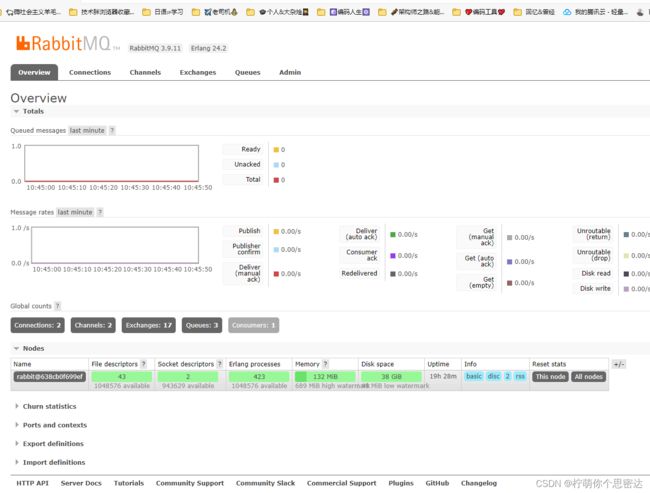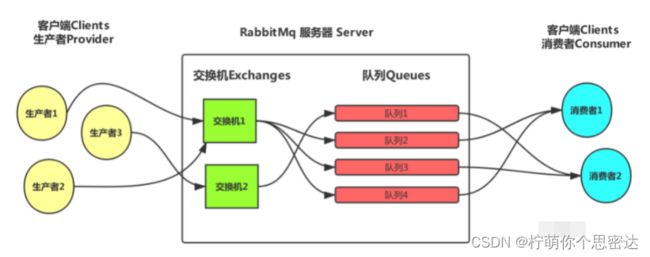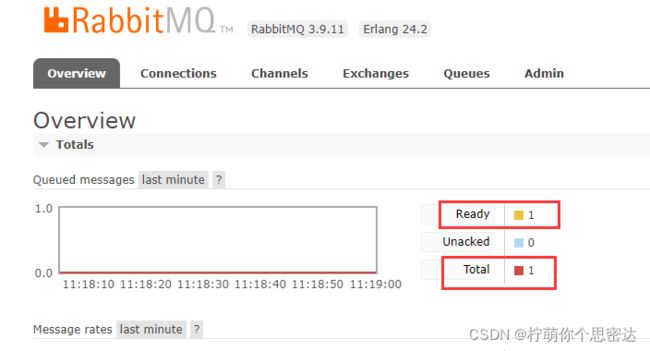手摸手系列之SpringBoot整合RabbitMQ详细教程
参考:Springboot 整合RabbitMq ,用心看完这一篇就够了
版本:SpringBoot 2.6.4
一、简介
在安装完RabbitMQ后,输入http://ip:15672/,可以看到一个简单后台管理界面。

在这个界面里面我们可以手动创建虚拟host,创建用户,分配权限,创建交换机,创建队列等等,还有查看队列消息,消费效率,推送效率等等。
首先先介绍一个简单的一个消息推送到接收的流程,提供一个简单的图:
黄色的圈圈就是我们的消息推送服务,将消息推送到 中间方框里面也就是 rabbitMq的服务器,然后经过服务器里面的交换机、队列等各种关系(后面会详细讲)将数据处理入列后,最终右边的蓝色圈圈消费者获取对应监听的消息。
常用的交换机有以下三种,因为消费者是从队列获取信息的,队列是绑定交换机的(一般),所以对应的消息推送/接收模式也会有以下几种:
Direct Exchange
直连型交换机,根据消息携带的路由键将消息投递给对应队列。
大致流程,有一个队列绑定到一个直连交换机上,同时赋予一个路由键 routing key 。
然后当一个消息携带着路由值为X,这个消息通过生产者发送给交换机时,交换机就会根据这个路由值X去寻找绑定值也是X的队列。
Fanout Exchange
扇型交换机,这个交换机没有路由键概念,就算你绑了路由键也是无视的。 这个交换机在接收到消息后,会直接转发到绑定到它上面的所有队列。
Topic Exchange
主题交换机,这个交换机其实跟直连交换机流程差不多,但是它的特点就是在它的路由键和绑定键之间是有规则的,简单地介绍下规则:
(星号) 用来表示一个单词 (必须出现的),# **(井号) 用来表示任意数量(零个或多个)**单词通配的绑定键是跟队列进行绑定的。
举个例子队列Q1 绑定键为 .TT. ,队列Q2绑定键为TT.#,如果一条消息携带的路由键为 A.TT.B,那么队列Q1将会收到;如果一条消息携带的路由键为TT.AA.BB,那么队列Q2将会收到。
主题交换机是非常强大的,当一个队列的绑定键为 “#”(井号) 的时候,这个队列将会无视消息的路由键,接收所有的消息。当 * (星号) 和 # (井号) 这两个特殊字符都未在绑定键中出现的时候,此时主题交换机就拥有的直连交换机的行为。所以主题交换机也就实现了扇形交换机的功能,和直连交换机的功能。
另外还有 Header Exchange 头交换机 ,Default Exchange 默认交换机,Dead Letter Exchange 死信交换机,这几个该篇暂不做讲述。
二、代码实现
1. 新建SpringBoot项目rabbitmq-server,做为RabbitMQ的消息生产者
pom依赖:
org.springframework.boot
spring-boot-starter-web
2.6.4
org.springframework.boot
spring-boot-starter-amqp
application.yml配置文件:
# 服务端口
server:
port: 8081
#rabbitMQ配置
spring:
application:
name: rabbitmq-server
rabbitmq:
host: 127.0.0.1
username: yorma
password: yormA2022
virtual-host: /yorma
接着我们先使用下direct exchange(直连型交换机),创建配置类DirectExchangeConfig(对于队列和交换机持久化以及连接使用设置,在注释里有说明,后面的不同交换机的配置就不做同样说明了):
package com.junya.rabbitserver.config;
import org.springframework.amqp.core.Binding;
import org.springframework.amqp.core.BindingBuilder;
import org.springframework.amqp.core.DirectExchange;
import org.springframework.amqp.core.Queue;
import org.springframework.context.annotation.Bean;
import org.springframework.context.annotation.Configuration;
/**
* 直连型交换机配置
*
* @author ZHANGCHAO
* @version 1.0.0
* @date 2022/3/8 10:03
*/
@Configuration
public class DirectExchangeConfig {
/**
* 交换机
*
* @return org.springframework.amqp.core.DirectExchange
* @author ZHANGCHAO
* @date 2022/3/8 10:09
*/
@Bean
DirectExchange directExchange() {
return new DirectExchange("directExchange", true, false);
}
/**
* 队列
*
* @return org.springframework.amqp.core.Queue
* @author ZHANGCHAO
* @date 2022/3/8 10:08
*/
@Bean
public Queue directQueue() {
// durable:是否持久化,默认是false,持久化队列:会被存储在磁盘上,当消息代理重启时仍然存在,暂存队列:当前连接有效
// exclusive:默认也是false,只能被当前创建的连接使用,而且当连接关闭后队列即被删除。此参考优先级高于durable
// autoDelete:是否自动删除,当没有生产者或者消费者使用此队列,该队列会自动删除。
// return new Queue("TestDirectQueue",true,true,false);
// 一般设置一下队列的持久化就好,其余两个就是默认false
return new Queue("directQueue", true);
}
/**
* 绑定。将交换机和队列绑定,并设置用于匹配键:directRouting
*
* @return org.springframework.amqp.core.Binding
* @author ZHANGCHAO
* @date 2022/3/8 10:10
*/
@Bean
Binding directBinding() {
return BindingBuilder.bind(directQueue()).to(directExchange()).with("directRouting");
}
}
然后写个简单的接口进行消息推送(根据需求也可以改为定时任务等等,具体看需求):
package com.junya.rabbitserver.web;
import cn.hutool.core.date.DateUtil;
import cn.hutool.core.util.IdUtil;
import org.springframework.amqp.rabbit.core.RabbitTemplate;
import org.springframework.beans.factory.annotation.Autowired;
import org.springframework.web.bind.annotation.GetMapping;
import org.springframework.web.bind.annotation.RestController;
import java.util.HashMap;
import java.util.Map;
/**
* 消息发送控制器
*
* @author ZHANGCHAO
* @version 1.0.0
* @date 2022/3/8 10:14
*/
@RestController
public class SendMessageController {
// 使用RabbitTemplate,这提供了接收/发送等等方法
@Autowired
private RabbitTemplate rabbitTemplate;
@GetMapping("/sendDirectMessage")
public String sendDirectMessage() {
String messageId = IdUtil.fastSimpleUUID();
String messageData = "测试direct message,欧耶!";
String createTime = DateUtil.now();
Map map = new HashMap<>(16);
map.put("messageId", messageId);
map.put("messageData", messageData);
map.put("createTime", createTime);
rabbitTemplate.convertAndSend("directExchange", "directRouting", map);
return "ok";
}
}
运行rabbitmq-server,然后用postman调用接口测试:
因为我们目前还没弄消费者 rabbitmq-client,消息没有被消费的,我们去RabbitMQ管理页面看看,是否推送成功:
很好,消息已经推送到RabbitMQ服务器上面了。
2. 新建SpringBoot项目rabbitmq-client,做为RabbitMQ的消息消费者
pom依赖:
org.springframework.boot
spring-boot-starter-amqp
org.springframework.boot
spring-boot-starter-web
application.yml配置文件:
# 服务端口
server:
port: 8082
#rabbitMQ配置
spring:
application:
name: rabbitmq-client
rabbitmq:
host: 127.0.0.1
username: yorma
password: yormA2022
virtual-host: /yorma
PS:消费者单纯的使用,其实可以不用添加DirectExchangeConfig配置类,直接建后面的监听就好,使用注解来让监听器监听对应的队列即可。配置上了的话,其实消费者也是生成者的身份,也能推送该消息。此处忽略。
然后是创建消息接收监听类,用来监听和接收消息:
package com.junya.rabbitmqclient.receiver;
import lombok.extern.slf4j.Slf4j;
import org.springframework.amqp.rabbit.annotation.RabbitHandler;
import org.springframework.amqp.rabbit.annotation.RabbitListener;
import org.springframework.stereotype.Component;
import java.util.Map;
/**
* 直连型消费者
*
* @author ZHANGCHAO
* @version 1.0.0
* @date 2022/3/8 10:27
*/
@Slf4j
@Component
@RabbitListener(queues = {"directQueue"}) // 监听的队列名称 directQueue
public class DirectReceiver {
@RabbitHandler
public void process(Map message) {
log.info("[test-direct]消费者收到消息:" + message.toString());
}
}
然后将项目运行起来,可以看到把之前推送的那条消息消费下来了:
然后可以再继续调用rabbitmq-server项目的推送消息接口,可以看到消费者即时消费消息:
思考:直连交换机既然是一对一,那如果咱们配置多台监听绑定到同一个直连交换机的同一个队列,会怎么样?咱试验一下:
新建一个监听接收类NewDirectReceiver:
package com.junya.rabbitmqclient.receiver;
import lombok.extern.slf4j.Slf4j;
import org.springframework.amqp.rabbit.annotation.RabbitHandler;
import org.springframework.amqp.rabbit.annotation.RabbitListener;
import org.springframework.stereotype.Component;
import java.util.Map;
/**
* 直连型消费者
*
* @author ZHANGCHAO
* @version 1.0.0
* @date 2022/3/8 10:27
*/
@Slf4j
@Component
@RabbitListener(queues = {"directQueue"}) // 监听的队列名称 directQueue
public class NewDirectReceiver {
@RabbitHandler
public void process(Map message) {
log.info("22222=>[test-direct]消费者收到消息:" + message.toString());
}
}
再次调用生产消息接口,可以看到是实现了轮询的方式对消息进行消费,而且不存在重复消费。

总结
direct直连型的exchange路由规则很简单:
exchange在和queue进行binding时会设置routingkey
然后我们在将消息发送到exchange时会设置对应的routingkey
在direct类型的exchange中,只有这两个routingkey完全相同,exchange才会选择对应的binging进行消息路由。




